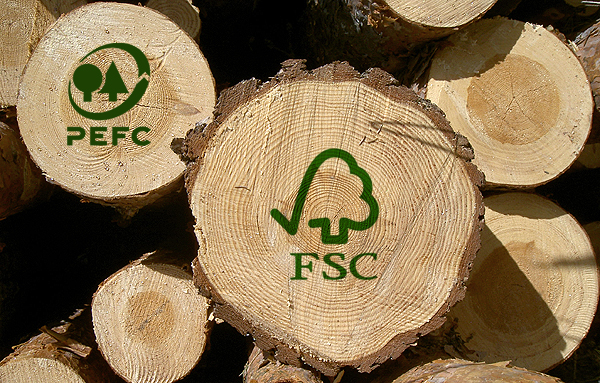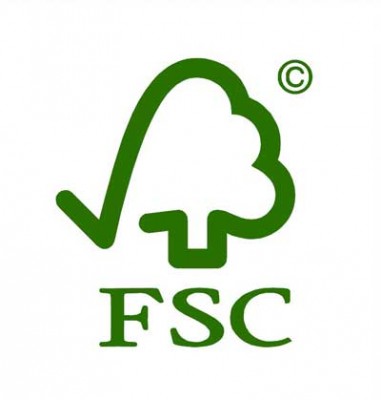Forestcertification is a written confirmation from an independent, qualified and accredited expert who verifies that the forest management meets the requirements set in the certification scheme. The criteria for sustainable forest management are defined by particular standards.
International criteria for a certification are:
- it is based on voluntariness
- it is accepted by all parties involved
- it hasinternational credibility
- it is impartial
- it is reliable
- it has been adapted to local conditions
- the standards are public and properly demanding
- the criteria can reliably measure the quality of forest management and use
- the criteria do not cause trade barriers
- the certification system must be equitable to all forest owners (e.g. it must take into account the small-scale forest owners)
- it is cost-efficient
- the system supports sustainable forestry
Further information:Forest Certification Resource Centre

The aim of the forest certification is to support environmentally, economically and socially sustainable forest management. Certification is a market-based way to promote sustainable forest management and to answer to the needs of the customers of wood processing industry, i.e. the retailers. The retailers can use the certification to support the competitiveness of their products in the markets.
A retailer can use the trademarked logo of certification in a product that has been made from a wood from certified forest. The use of the logo requires that the origin of the raw wood material can be proved in the various stages of transportation and production.
Forest certification is growing rapidly. There are more than 50 certification systems throughout the world. For instance the international Forest Stewards Council is a non-profit and open organisation that accepts organisations and any interested persons as a member.
International Forest Certifivcation Systems

PEFC (Programme for the Evaluation of Forest Certification schemes) www.pefc.orgis an umbrella organisation for national forest certification schemes all over the world. Under the PEFC umbrella the national schemes can co-operate with each other to ensure that the wood from each scheme meets equivalent standards.
- The members of the PEFC represent national or local certification systems that have independent experts to assess the forest management. The certification systems are based on internationally agreed principles that are integrated with local circumstances. In Europe the principles have been agreed upon in the ministerial meetings of forestry.
- The PEFC was founded after years of development work in 1999. Since its launch it has become the world’s largest umbrella organisation for national forest certification schemes all over the world, ensuring the delivery of hundreds of millions of tonnes of wood to the processing industry and then onto the market place from tens of millions of hectares of certified forests. PEFC have strong grass roots support from many stakeholders including the forestry sector, governments, trade associations, trade unions and non-governmental organisations. The Finnish Forest Certification Council is the representative of PEFC in Finland.
- PEFC provides a framework through which national and regional certification schemes can integrate internationally agreed criteria with their local circumstances. The PEFC logo can be used in marketing the wood and paper products that originate from the PEFC certificated forests.

The Forest Stewardship Council (FSC) www.fsc.orgis an international organisation founded in 1993.
- FSC has ten principles of forest stewardship that are used as a basis for national certification criteria.
- On international level most of the FSC certificates that have been granted follow the companies’ own instructions or regulations and the ten Principles of Forest Stewardship without a national FSC standard.
- In the Netherlands the system used by the wood importers is called the Keurhout.
Differences in the certification systems
In 2005 two articles were published that pointed out that forest certification systems have different kind of emphasis on economical, social and ecological aspects of forestry.
The World Wild Life Fund (WWF) compared the FSC and PEFC systems in 2004-2005. There were experts of forest certification systems and independent scientific committee taking part in the study carried out in Finland and 11 other countries. The actual study was implemented by an independent consulting company Pro Forest from Great Britain. The study showed clear differences between PEFC and FSC systems. According to the WWF in both systems there were found some aspects needing further development, but the PEFC more so.
WWF is not committed to any forest certification system, but it wants to recommend those who best promote responsible wood sourcing and production according to impartial studies.
UPM’s Parallel field testing of forest certification standards indicates: Five standards promote economic, social and environmental forest management with differences in emphasis
The parallel testing of forest certification standards started by UPM in summer 2004 shows that FFCS, the most commonly used standard in Finland, the Finnish draft FSC, Swedish FSC, North American SFI and UKWAS used in UK achieved a balanced approach, but with differences in emphasis to promoting the economic, social and environmental management of forests.
According to the test there are significant differences between the various standards in the number of criteria used for any one subject area, as well as in the scope and threshold requirements. The differences not only occur between standards in a country, but also between national standards within the same scheme. This reflects the local conditions and the values of the stakeholders who have been involved in standard setting processes. For example the lack of substantive industry participation in the FSC Maritime standard, and to some extent the draft FSC Finnish standard, has led to standards that have a greater focus on environmental and social issues. In contrast the absence of NGO support in developing FFCS in Finland has led to lesser focus on environmental and social criteria.